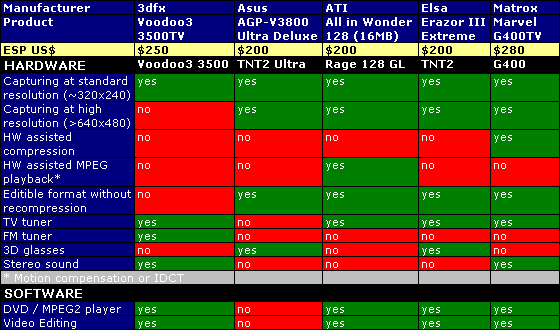Multitalented: All-in-One Graphic Boards
Recommendations?
No single board stood out as the absolute leader in this test! However, the 16 MB version of ATI's All in Wonder 128 is in first position. It offers space-saving MPEG recordings at maximum television resolution. A particularly positive aspect of the board is its low price at only 200 dollars. The Philips TV tuner delivers pictures in very good quality. However, two things stopped the board from obtaining the recommendation of the test team. Firstly, you need a powerful CPU (at least a Pentium III 550) in order to record space-saving MPEG 2 videos at full TV resolution in real-time. However, lower resolutions or other formats can be achieved with less powerful processors. Secondly, the software bundle doesn't contain Ulead's VideoStudio 3.0. This is only included in the 32 MB version. VideoStudio 3.0 implements a special plug-in that can be used to edit MPEG 2 videos without converting (recompressing) to other formats first.
We hesitated to recommend the 32 MB board because the ATI drivers aren't mature yet. It's hard for us to understand why, in comparison to the 16 MB version, the TV playback requires so much of the CPU's resources. Switching between the channels can take up to 1 second. If a transmission changes from mono to stereo transmission, then strong tone fluctuations are apparent. The filtering of TV pictures is also not optimal. The All in Wonder 128 32 MB is still relatively new and has a different tuner (Temic) and a new capture chip, the Rage Theater. If ATI improves the quality of its drivers for this board to that of the 16 MB version, then the manufacturer can expect to receive our recommendation shortly afterwards. So let's wait for a while.
Second place goes to Matrox's Marvel G400TV. Despite the high price of almost 280 dollars, the board books gets plus points for a particular feature: video recording is virtually independent of the CPU in the system. This is due to the Zoran chip that records videos in MJPEG format without time delays. The 'Avid Cinema' software is particularly well suited for beginners, first attempts can be made without having to consult the manual first. However, the MJPEG format requires up to five times more storage space compared to the MPEG 2 format. This situation is somewhat relieved by the supplied LSX transcoder software from Ligos. Once a user has finished editing a video, it can be converted to the MPEG 2 format, however, this procedure is very time-consuming. If hard disk space is no object for you then the Marvel is the best choice.
Get Tom's Hardware's best news and in-depth reviews, straight to your inbox.

